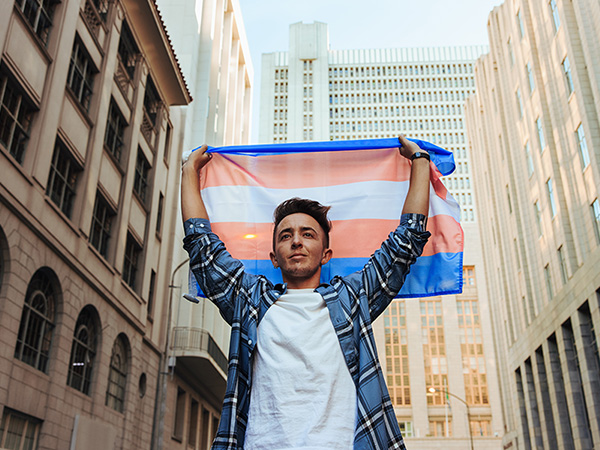
What does it mean to be truly represented and valued within your organization? This is an important question for many diverse groups, and the LGBTQIA+ community is no exception. Each June, NIH celebrates Pride Month to honor the extraordinary LGBTQIA+ individuals who contribute to our workforce. For the next 30 days, the transgender flag will wave above Building 1 on NIH’s Bethesda campus. The transgender flag is an important symbol for the LGBTQIA+ community and their allies, and without transgender people, there would be no Pride.
Origins of Pride: Exploring the History and Meaning of the Transgender Flag
“Seeing the transgender flag fly at NIH on our day of visibility makes me feel safe, supported, and protected like nothing else. It is an unequivocal statement that we are a united community. [The flag represents] that everyone, including transgender and gender non-conforming people, belongs here. Now more than ever, it is vital to shine this light of love, tolerance, and understanding for all to see." - Willow, MSW, Program Analyst, Sexual & Gender Minority Research Office
Marsha P. Johnson, a gay, Black transwoman, and Sylvia Rivera, a Puerto Rican transwoman were two of “the most prominent figures of the gay rights movement of the 1960s and 1970s in New York City.” Best known for their courageous resistance at the Stonewall Inn on June 28, 1969, Marsha and Sylvia were instrumental in “[advocacy] for homeless LGBTQ[I]+ youth, those affected by HIV and AIDS, and gay and transgender rights” according to the National Women’s History Museum.
These inspiring women embodied how equality is an intersectional endeavor and that transgender rights uplift the rights of all people. To strive for transgender rights is to strive for human rights.
“To see the transgender flag displayed at NIH on Transgender Day of Visibility reminded me that despite all the anti-trans rhetoric in recent years, there is a powerful movement underway to recognize and celebrate difference as a core principle by which we must all continue to aspire.” - Courtney White, Senior Administrative Officer, National Institute of Mental Health
A Flag for Every Identity: Representation Around the World
Marsha and Sylvia’s intersectional identities and persistent work toward equality are why NIH and people around the world raise the transgender flag. Originally created by transwoman and Navy veteran, Monica Helms, in 1999, this important symbol made its debut in 2000 at a Pride parade in Phoenix. Monica’s color choices are both deliberate and meaningful: “The light blue is the traditional color for baby boys [and] pink is [traditionally] for girls, and the white in the middle is for those who are transitioning, those who feel they have a neutral gender or no gender, and those who are intersexed.” Monica helped preserve transgender history in 2014 when she donated multiple objects to the Smithsonian Institution which included a miniature transgender flag. The flag remains a permanent collection item at the National Museum of American History.
“Seeing the transgender flag displayed in front of Building 1 reinforces the positive vibe I have received as a female transgender [person] from colleagues at NIH since my transition in 2013. The flag is a symbol of NIH's commitment to support[ing] people like me, which makes me feel proud as well as serene.” - Michelle Boyle, Special Assistant to Director/Deputy Director
Inclusivity at NIH: Honoring Our Colleagues and Creating a Diverse Workforce for Everyone
We honor the steadfast determination of the LGBTQIA+ community to achieve recognition, acceptance, and equality. For members of NIH’s workforce who identify as transgender or gender-nonconforming, the flag can serve as a source of pride, visibility, and validation. The flag can also help to create a sense of belonging among LGBTQIA+ employees and send a clear message that our agency is committed to creating an inclusive and supportive environment for everyone, regardless of their gender identity or expression.
Be a part of building that environment by taking a SafeZone Training offered throughout the year or visit our Sexual and Gender Minority page for more information about the portfolio.
Do you have a story idea for us? Do you want to submit a guest blog? If it's about equity, diversity, or inclusion, please submit to edi.stories@nih.gov.
For news, updates, and videos, subscribe or follow EDI on: Twitter, Instagram, Blog, YouTube.






